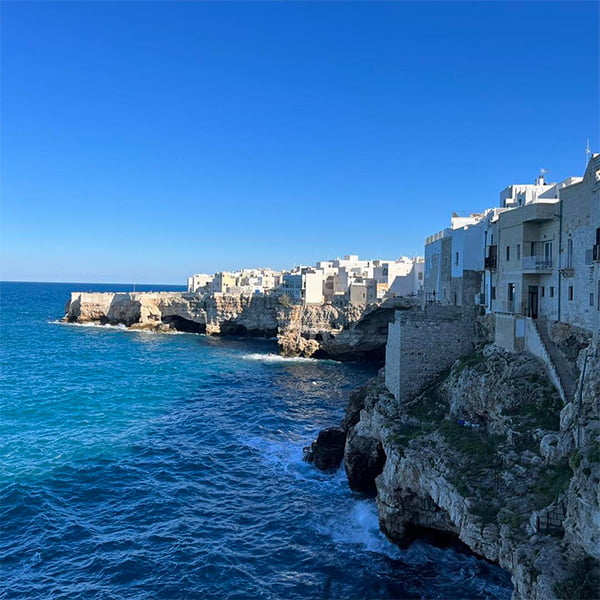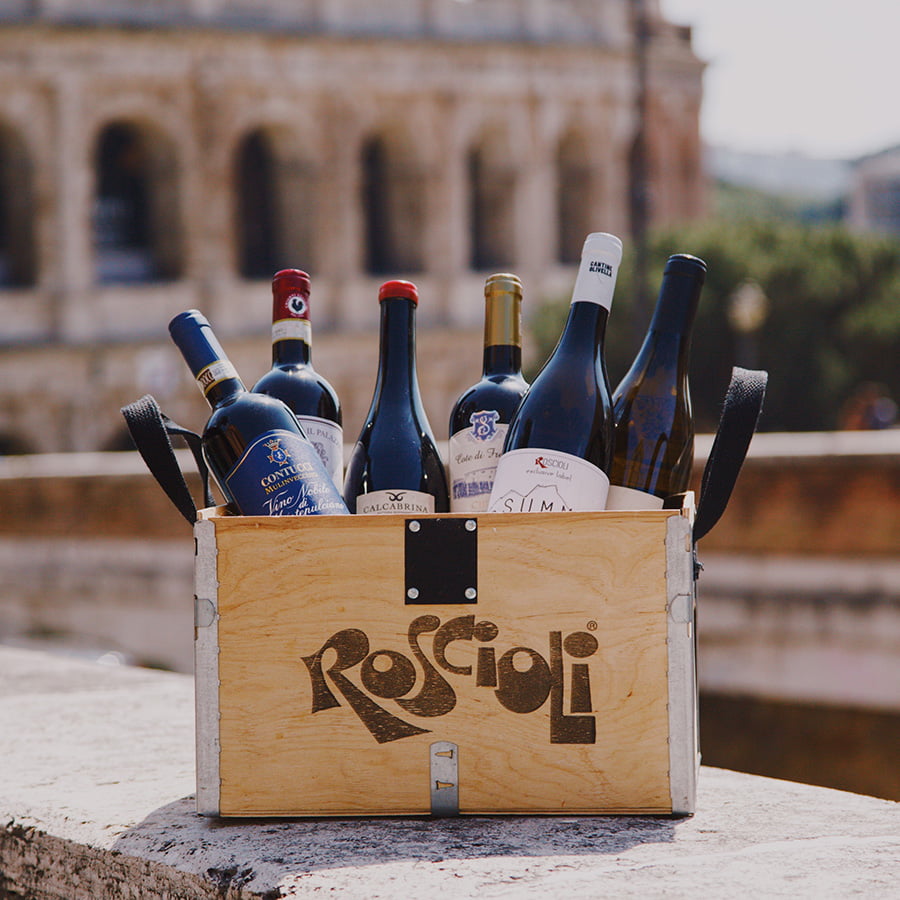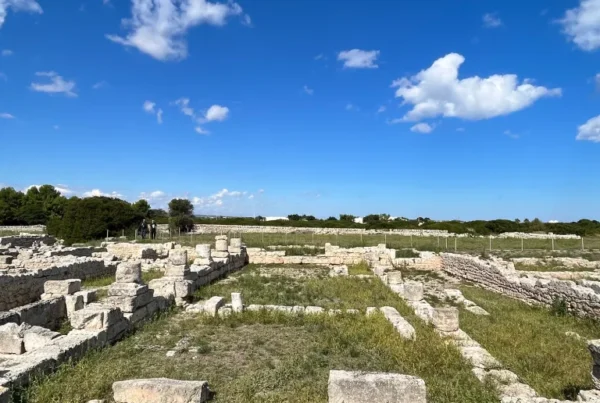In the south of Italy, Matera is famous for cave dwellings in which people lived until the mid 20th century and which you can experience for yourself today.

Matera is an ancient city perched on a rocky outcrop in the southern Basilicata region of Italy.
Once known as “The shame of Europe”, the unique architecture of Matera’s district of cave houses and park of Rupestrian churches was declared a UNESCO World Heritage Site in 1993.
Nowadays, visiting this southern Italian town offers a unique insight into what life was like for many people in this previously impoverished area.
Matera Italy is a key destination in our Puglia and Basilicata Tour which takes in a wide variety of cities, towns, hidden spots, olive producers, wine makers, and delicious meals in this under appreciated region of Italy.
If you are a wine lover, I have something special for you…
There are few things better in life than a good glass of wine and with this we’d like to introduce you to the Roscioli Italian Wine Club. Roscioli are a Rome institution, famous for their artisan Italian food and drink.
This is no normal wine club however. As a member you will receive not just two deliveries of wine per year, but a whole host of additional benefits including free tasting dinners in Rome and NYC, VIP access to Roscioli’s exclusive events, and complete information about your wines if you’re interested in learning about them.
Join now and use code ADVENTURESWITHSARAH to save 25€ on your first delivery!
Is Matera, Italy Worth Visiting?
The simple answer? Absolutely!

The unique, outwardly medieval city of Matera hides an even more ancient settlement within and is not to be missed.
History Of Matera
Matera is one of the oldest cities in the world. It is believed that Matera was the site of a prehistoric troglodyte settlement and that the first humans in Italy settled there as early as 7000 BC.
The Sassi di Matera is the name given to the two districts of Matera; Sasso Caveoso and Sasso Barisano which are perched on the edge of a steep ravine. The Sassi are famous for the underground network of caves which contain homes, churches, warehouses and even giant reservoirs.
The history of Matera Italy is one of mixed fortunes. Like many Italian cities throughout the centuries it has been invaded and traded by different rulers.
By the mid 20th century it had become “The shame of Europe”. In 1952 the Italian government evacuated the Sassi di Matera due to poor living conditions and the ancient town was effectively abandoned.
Even up until the 1980’s the Sassi caves were deemed uninhabitable. However, the current local administration recognised the value of tourism and promoted a regeneration program for the cave networks, allowing them to be re-used.

There are now many thriving businesses in the Sassi and Matera is one of the fastest growing cities in Southern Italy.
A complete turn of fortunes happened in 2019 when Matera was designated European Capital of Culture.
What to do in Matera, Italy
Visit the Matera caves
When visiting Matera, the main attraction is the UNESCO World Heritage site of the ancient cave system.
Matera’s Sassi contain complex cave networks covering an area of 1,016 hectares. It is the most outstanding example of a troglodyte settlement in the Mediterranean region and has been continuously inhabited for over 2000 years.
You can meander through the streets and visit a cave house (casa grotta) of which there are more than 1000, along with Rupestrian churches carved into the rock face.

Discover the cave churches
Matera’s caves contain over 150 rock churches with many ancient frescoes on the cave walls. They are reminiscent of architecture found in the Holy Land and show the progression of Christianity throughout the centuries.
You will find them in both the Sassi districts and the Parco della Murgia Materana.
Some of the best examples of these rock churches to look out for when visiting Matera are:
Il santuario della Madonna delle Tre Porte – This is one of the oldest churches in Matera and is famous for its three entrances and wonderful frescoes in the main nave.
Santa Lucia alle Malve – This is one of the most important churches in Matera. It was the first female monastic settlement of the Benedictine Order and dates back to the 8th century. There are also examples of incredibly well-preserved frescoes that date back over 1000 years.
San Pietro Barisano – This is the largest rock church in Matera dating back to the 12th and 13th centuries.During renovations in the 18th century, underground rooms for the “draining of corpses” were added. This practice, which was reserved only for dead priests or aspirants, involved placing the corpses in sacred vestments in niches in the tufa. Only once their mortal remains had decomposed were they removed.
Santa Maria de Idris – Dating back to the 15th century, this church carved into the rocks offers stunning views over the city and the Gravina.
- San Pietro e Paolo – As a contrast, you can also visit one of the city’s Baroque churches. The church of San Pietro e Paolo, is a great example and has beautiful views.
Eat in a cave restaurant
When you visit Matera you cannot miss experiencing dinner in a cave restaurant.
Many of the cave restaurants serve homely, simple Italian dishes based on the concept of cucina povera. These are recipes that were developed to be delicious and affordable using locally available ingredients.
Why not try the Trattoria del Caveoso? The Basilicata Trattoria del Caveoso serves up traditional Lucanian cuisine in the heart of the Sassi.

Stay in a Matera Cave Hotel
Matera has dozens of cave hotels and B&Bs. Staying in one of the cave rooms guarantees an unforgettable Matera visit.
Visit Piazza Vittorio Veneto
This square in the historic centre of Matera is worth visiting for two reasons:
There are excellent panoramic views of the Sassi area. The facade of the Cathedral lines up perfectly with the streets of the Sasso Barisano winding below with its labyrinth of narrow stairways and alleys.
Climb down an unassuming staircase next to the fountain and you will discover an underground city. The underground rooms extend for more than 5000 square meters and include snow tanks, underground cisterns, shops, warehouses and homes.

Stroll Via del Corso
Walk along Matera’s main road and explore modern boutiques and restaurants. You will also be able to enjoy spectacular views of the city.
During the Festa della Bruna, which takes place on 2nd July, this part of the city and the city’s main square are adorned with extravagant light decorations to celebrate the parade of the city’s holy protectress.
Visit Casa Noha
Until 1952, people in Matera lived in caves. Casa Noha was donated to the city by its former owners. Nowadays this small museum gives a great insight into what life was like living in the caves.
The video documentary is well worth watching before exploring the rest of the city.
Visit the Casa Grotta di Vico Solitario Museum
Located in the Sasso Caveoso, this is one of the best preserved examples of a cave house. It is furnished with period furniture and artisan tools and gives the visitor a good idea of what it was like to live in a cave.
Browse Matera’s art museums
Despite its small size, Matera is home to two of the most important art museums in Italy: MUSMA Museum of Contemporary Sculpture (which is entirely dedicated to sculpture) and the National Museum of Medieval and Modern Art.
Discover famous film sets

Matera and many of its surrounding towns have been used as sets in several Hollywood movies.
You can visit the towns of Aliano and La Martella which were featured in the film adaptation of ‘Christ Stopped at Eboli’ by writer Carlo Levi. This memoir of his time spent in exile in Basilicata depicts the struggles faced by those living in the region in the 1930’s.
Like a mini Matera, the nearby town of Gravina is famous for having been a set location for the James Bond movie ‘No Time to Die’.
Visit the neighboring Puglia region
Is Matera in Puglia? No, this is a popular misconception, but it is very close by. The neighboring region of Puglia is home to stunning coastlines and scenery, and some of the finest olive oil, wine and cheese that Italy has to offer.

Getting to Matera, Italy
Where is Matera Italy? And how to get to Matera, Italy?
Matera by Car
You can hire a car from any international airport and driving to Matera is fairly straightforward. However, do be aware of the ZTLs (Limited Traffic Zones) which restrict access to certain parts of the city.
Matera by Plane
The closest airport is in the southern Italian city of Bari.
From Bari airport you can catch a bus to Matera which takes approximately 1 hour and costs between €5 – 20. Alternatively, you can hire a taxi.
NOTE: Some buses stop about a 30 minute walk from the Sassi.
Matera by train
TIP: Be aware that Trenitalia does not run trains in this area. You have to connect to the Ferrovie Appulo Lucane in Bari.
The local train leaves from a separate train station next to Bari Centrale.
The train takes approximately 1 hour 45 minutes and cost €4 -6. Matera Centrale is only a 5 minute walk from the Sassi.
Discover the magic of Basilicata & Puglia
Puglia and Basilicata are fascinating, yet under appreciated regions of Italy. If we think of Italy as a boot, these regions cover the heel and instep, sandwiched between Adriatic and Ionian Seas.









I wish there was an easy way to print so I could bring this info with me!
Using the Matera Travel Guide enhanced our understanding of this enchanting city and helped us explore its historical charm. I highly recommend it